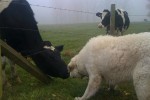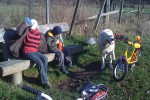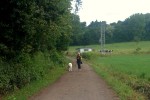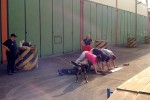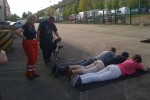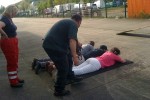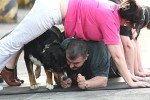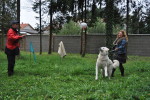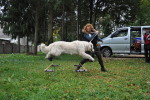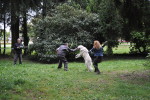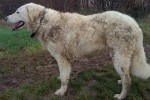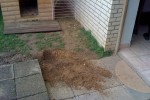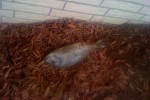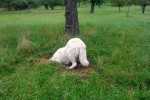The first year, in which we visited the puppy school and
later youngster class once a week, was very important for her
development later. She learned to deal with smaller breeds and to
slow down on her power. Even now since she is grown up I don’t need to worry if she is playing off leash with a Chihuahua or a West Highland Terrier. (If she gets a chance to play at all with them since most of them unfortunately get picked up when they see her, most probably a result of some bad experience of the owners.)
The dog school and the exercises in everyday life have given her the biggest freedom: She is able to walk off leash outside. Three times a week we are going for a run through the forest to Frankfurt and back. Our regular walks also lead us into the forest in which a lot of deer, rabbits and goose live. The fields and forest near Maintal are nearly everywhere classified as nature and landscape protection area. With a Kuvasz you start to have a 180°-view – if not even 360°– and if you keep an eye on your dog during the walk, you are well prepared and can react accordingly. I can see by the movements of her ears and head if something is coming up and can call her early enough. The biggest freedom for both of us is that we don’t need to avoid any fellows on our walks. Around here on the fields most dogs are off leash, hence most greetings are without any stress and if Duna meets a nervous and scared dog, she knows how to send calming signals and stays friendly. It is clear that this job is easier to manage with a female dog than with a male.
Duna doesn’t care if joggers or bicycles pass her; she is used to it right from the beginning. She is paying attention, sometimes turns around to look if we passed someone but doesn’t get distracted if there is no reason for it. If someone approaches us without dog, I put her shortly on leash or hold her collar, but only to be considerate of the person. What small dogs are allowed to do and get smiled at is not allowed for our white giants. We are responsible for consideration and to work on the good reputation of our breed.
Following the dog school for young dogs we implemented the things we learned in our everyday life and in the end we can say, that not mainly the dog school but the time we spent together and the things we did, brought us nearer together and eased our communication. Both dog and human learned to read and understand the body language of the other and today we are a very harmonic entity. Today it is possible to communicate with Duna with the help of a whole set of commands, which we partially created ourselves and suit us: Gyere! (Come), Ide! (Over here, come to me), Ülsz! (Sit), Feküdj! (Down), Marad! (Stay), Állj! (Stop), Lábhoz! (Heel), Kifele! (Out! – out of the appartment, out of the room, out of the field), El! (Away, go away), Ne bánts(d)! (Don’t hurt me or him! – from puppyhood to stop the biting and nibbling, still counts today as signal to be careful with someone or to stop a game allowing rougher interaction before but ending it with the command. Hagyd! (Leave it! – if it is not worth getting into something with another dog or to ignore the barking small dog across the street, simply ignore and continue to go your own way), Szépen! (Be nice! – to behave friendly towards humans or other dogs, as an Okay from me), Lassan! – (Slowely – while walking or taking something out of a hand gently), Erre! (Different direction, than the one she follows, meaning always in my direction, Nézd csak! (Look! – to get her attention and sometimes to get her attention away from something), Vigyázz! (Careful! If cars are on the field track or if I consider something as dangerous).
Hopp! (Hopp – jump up, jump over, jump into the trunk), Járda! (Pavement/Sidewalk – if we are cycling or walking to tell her to go back on the sidewalk and not walk on the street), Át! (Cross – to cross a street or jump over an obstacle), Futás! (Run – walk faster), Tovább! (Go on)
Fogd! (Take it – take, hold or carry a ball, toy, food ball or goodies), Ereszd! (Give – to let go of a ball, food, etc.), Köpd ki! (Drop it/Spit it out – collected and undefinable stuff from the fields), Kérem! (Let it go), Hozd! (Bring – retrieving), Keresd! (Search! - Ball, food, humans, etc.), Labda! (Ball – she either brings the playing ball or the food ball, if the wrong one I simply say Másik! – meaning the other).
Egyél! (Eat! She is only allowed to take the food after waiting for this command, no matter if out of her bowl or in her food ball or if I hid some food in the garden. To do so I give her the commands „Sit!“ and „Stay!“, hide the food in various and difficult places to reach like a tree trunk, branches or a hanging tire, below a bucket and once I am finished, she gets the command „Search!“. She dashes away and searches the spots in the order she remembers, the rest gets done with the help of her nose. Igyál! (Drink – outside when we stop on a small creek or river).
For the tricks the kids taught her we use: Pacsi! (Paw), Másik pacsi! (The other paw), Guri-guri! (Roll over), Puszi! (Kiss, licking allowed, nudging with nose).
Although some people might laugh about it, even natural needs can be encouraged by a command like Pisi! (Pee) and Kaki! (well, I don’t think we need a translation here), which can be very helpful if you are for instance on vacation and dogs are not everywhere allowed to do their business or on the fields or places where it simply is not allowed like entrances of gardens, fences or on cultivated fields. With the help of regular walks – and when they are grown up with only a minimum of two walks a day – you can keep your own garden totally clean, which we appreciate very much. In the end we would still like to enjoy our garden...
It gets pointed out over and over again that a Kuvasz does not have the slavish obedience of a German Shepherd. We need to be aware of that to not be disappointed of our dog later. It is a total different way to deal with a Kuvasz and we should be happy if our dog works with us due to his affection and respect. But we also should not set our targets too low and excuse our giving in and inconsequence by saying „Typical Kuvasz, the breed is used to work independently.“ We define what we can expect from our dog already when he is a puppy; we are responsible what we show him of the world in his socialization phase. When the dog is one year old and sees for the first time other animals or gets to hear noises like a lawn mower, motor saws, tractors etc., it might be too late.
Following the dog school we wanted to discover further options to educate Duna and joined a beginners’ class of a rescue dog club (BRK Rettungshundestaffel Mainz-Kinzig e.V.) in Gelnhausen. On the public shows of the rescue dogs I was always fascinated by the concentrated work of the dog and the invisible bond to the owner. In theory and practical classes in 10 appointments we had the following subjects: Positive motivation of the dog by playing, direct and guide the dog on distance, using hearing and hand signals to communicate with the dog, working with equipment to enhance motor activity, alert exposed persons, basics to alert buried persons, area search in the forest, the process of an assignment, First Aid Dog.
Right on the first evening it showed Duna can be easily motivated by food, which wasn’t really a surprise for us. But I was astonished that not every dog can be. While one dog is working the others were waiting out of sight in the cars. Duna hardly couldn’t wait until it was her turn to fullfill the next task. She obviously enjoyed it very much and it was hard to explain for me that she normally is really quiet. It was nearly impossible to control her when she was supposed to search for the hidden person and she found all of them. Using the equipment she showed no fear, even though some of them were quite small and instable for her size. In the tunnel it was close for her to get through and not get stuck. Following the beginners’ class people who were successful with their dogs can start their training, which takes place three times a week, one is a day on the weekend and often there are longer rides to distant training grounds. It is a pity that rescue dog work requires such an enormous personal, financial and time effort. Doing the training I really had the feeling it was the right occupation and mental exercise for Duna. I was very proud of the fact that Duna amazed the whole group and stood against the prejudices against her breed. No one expected such a friendliness, dedication and excellent nose work of a Kuvasz. Here you can find a few pictures of the website of the rescue organization with some comments:
|
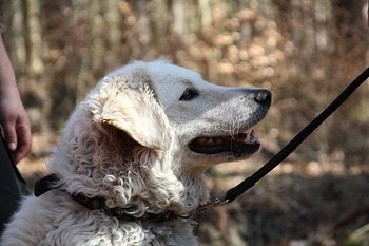
Kuvasz Duna is such a cuddle bear...
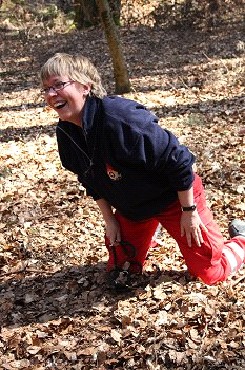
... but even the head of the team, Claudia, had difficulties holding her...
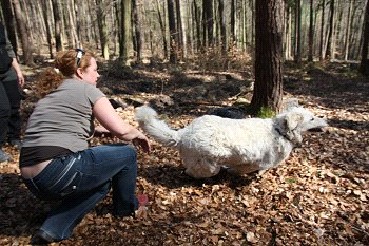
... when she was racing with enormous power to the helper...
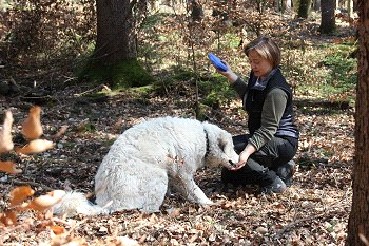
... and to get her reward.
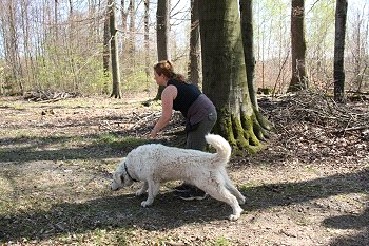
Also today Duna shows herself ...
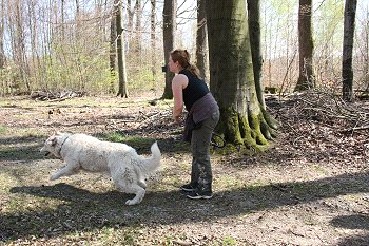
... highly motivated ...
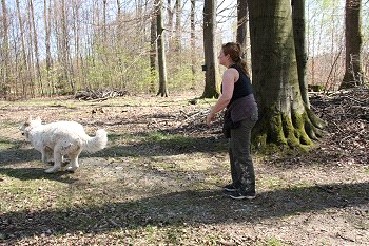
... and was hard to stop.
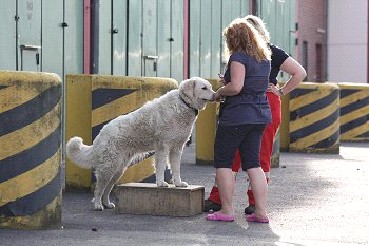
Just enough space for Duna...
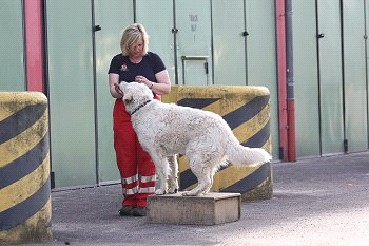
... on the mark.
|
Later on we visited a walking group of a dog school on the weekends, which organized dog walks with 10-15 dogs off leash through the forest. Here we also took part in a seminar about target object search (in German Zielobjektsuche, short ZOS). ZOS is an independent discipline in dog sports.
Due to Duna being in heat or the shows we visited on the weekends this activity was more sporadic. But we are always looking forward to new seminars and subjects we can try. We have made us of the most important parts and useful things for everyday life and have discovered qualities of a Kuvasz we didn’t expect.
On the Club show of the MEOE Hungária Kuvasz Klubs we had the opportunity to show our cooperation. To get approval for breeding some exercises of the working trials are required. When the judge team saw how excited Duna was waiting for her next task, they suggested to us to take part in the trial spontaneously. We both had a lot of fun which also can be seen in the end result of 96,6%. Even though we taught her all the time to stay friendly towards humans, she showed us during the protection dog exercises that her Kuvasz genes are not sleeping and reacted as expected. Because this kind of test or trial doesn’t exist in other countries, I will list the parts of the interesting test:
1. Reaction of dog among foreign people
a) when a person shows up
b) in a group of 4-5 people who move around
c) the circle closes around the dog
2. Ignoring of noises
a) throwing a noisy box, approx. 1 m away from the dog from a height of 1 m
b) The dog walks around on leash, while around 20-25m away from the dog two 25-35 cm wide and 40-50 cm long baords get beat together twice
3. Reactions to unexpected situations
a) opening an umbrella in the direction of the dog, direction sky, 45°
b) walking on leash between obstacles (Flag, baby buggy, balloon, etc.)
4. Reactions to a fireplace
a) stop the dog approx. 1 m in front of the fire
b) walk around the fire on a marked path
5. Protection exercise in a group (with a few dogs at once)
6. Individual protection exercise next to the dog handler (watching the reaction of defense, fight against the agitator)
7. Retrieving (handler rolls or throws an item away)
a) curious, interested, follows the item
b) retrieves the item back to the handler
8. Mobility, Constancy
a) jump twice over a 40 cm high hurdle
b) twice wide jump 1 m
9. let dog lay down, wait and call back
a) the dog stays 10 seconds long approx. 8 steps away from the handler
b) calling back to handler
10. Ability to solve problems (searching for food on detours)
11. Individual protection work in the absence of the handler. At the end of the exercise neutralizing and watching the calming reactions.
Further pictures of the contest are in NEWS - 2010 - October 2010 and in the Gallery.
To make sure our report stays authentic and we don’t create a picture of Duna as a saint, we also show her little stunts. Among these examples is a situation in which Duna put some „perfume“ on for a Kuvasz male. No matter how often we showered and washed her, this fragrance staid nearly a quarter of a year. It was definitely also my fault because I ended up in a very nice conversation with the owner of the Kuvasz male and was so fond of meeting a Kuvasz on the fields, that I let my sweetie too long out of sight. Or we show a new way to preserve fish. I think our experimental Duna also was not happy about the result.
|
![]()
![]()
 E-Mail
·
E-Mail
·  Facebook
·
Facebook
·  Seite drucken
·
Seite drucken
·  Impressum
·
Impressum
·  Datenschutz
Datenschutz















